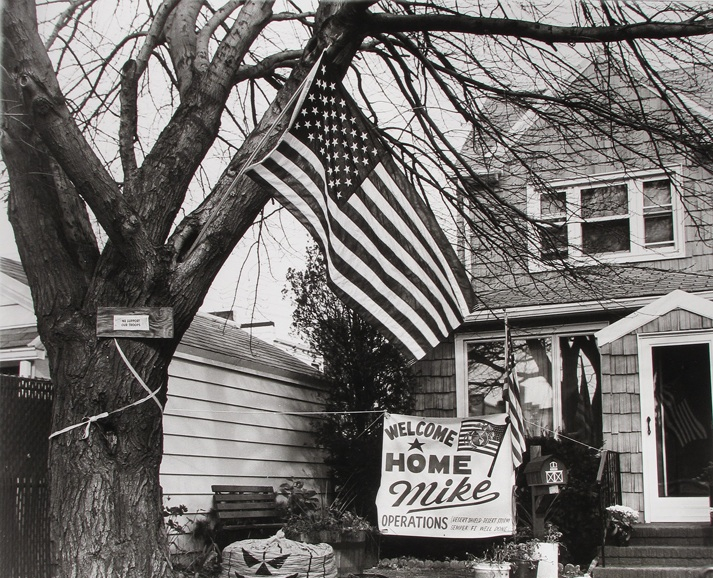

On March 18, SUNY New Paltz started its spring break, which gave many students a chance to return home, re-unite with old friends and visit familiar places. It also marked the closing of “Thoughts of Home,” an exhibit at The Dorsky featuring a collection of photographs that focus on the home as a place of great emotional experience.
“Thoughts of Home” opened to students and the public on Aug. 18, 2010. The exhibit was comprised of 41 photographs on loan from the Center for Photography at Woodstock, showcasing people and their homes. Arts Collections Manager and Curator Wayne Lempka organized the event, and he said the photos are meant to evoke a wide range of emotions that people can relate to.
“Home is a refuge,” said Lempka. “It’s a place to get away from the craziness of daily existence.”
As a curator, Lempka is responsible for picking the theme of the exhibit and proving why the theme is important. Lempka was in charge of looking through the 15,000 photos on loan to The Dorsky, and choosing the ones he felt most effectively captured different aspects of life from around the country.
The exhibit was made up of color print, and gelatin silver print photos. The pictures captured specific moments in time, like a woman washing her hair in the kitchen, and a family at Thanksgiving dinner. The photographs were taken all over the country. There were rag-tag shacks with statues of Jesus and American flags from the Deep South, as well as shots ranging from dirty basements to expertly designed living rooms. To Lempka, these photos allow us to see the scope of humanity.
“Every photo is full of stories,” said Lempka. “These photos allow us to stop, smile, laugh and feel sorry. They show how our homes act like a bulletin board.”
Lempka said the photos displayed in the exhibit are aimed at showing how a person’s environment can directly reflect who they are. This became a popular trend among late 20th century photographers.
“In the ‘80s, and even dating back to the 1960s, photographers began to focus on the familiar,” said Lempka. “Photographers and artists were afraid that the advancements in technology were creating a lonely existence.”
Lempka said the exhibition was planned three years ahead of time, and took two months to produce. He and his staff of graduate students, assistants and interns needed to mat, frame and place the photos in very precise ways around the gallery. Lempka also used quotes from a 1998 independent study entitled “What Does Home Mean to You?” The quotes were placed between pictures on the walls in a gray print. Two of the quotes were “home is somewhere to shut out the rest of the world,” and “home is family.”
Lempka said he has really enjoyed the experience of bringing his vision to life. His office sits right above the gallery, and he said he enjoys glancing over, and noticing which pictures people take a second look at.
“I think what makes this exhibition so fascinating is we can stare into people’s lives and not feel uncomfortable,” said Lempka. “The drapes are drawn, and we are welcome to look in.”
Second-year Rich Cali began working at The Dorsky last fall as a Gallery Assistant. He said home is a place he can go for anything. Cali said he enjoyed the exhibit, especially one particular picture.
“There was a picture of Lou Reed and Andy Warhol sitting together in a room that was really cool,” said Cali.
Second-year undeclared Liana Ryans works with Cali at the museum. They stand guard at a distance, keeping an eye on the spectators, making sure nobody touches the artwork.
“To me, my home is where I feel most safe,” said Ryans. “It’s a place where I can be calm, and it’s a place I can relax.”
When Lempka began working at SUNY New Paltz 13 years ago, The Dorsky didn’t exist. Like photography, SUNY New Paltz has gone through many changes throughout the years. Lempka said he is proud of the diversity of the exhibitions in The Dorsky, and he wants students to know they are given an incredible resource and they should take advantage of it.
“It’s not just for art students,” Lempka said. “You could know nothing about art and enjoy this exhibit. Stop in, and enjoy it. There is always something that will peak your curiosity.”
Lempka said the exhibit is great because people can relate to it.
“The thing that’s so great about the exhibit is that everybody can relate, because everybody has one,” said Lempka. “It’s interesting to see how objects and people can reflect what home is. Things we collect can really express our personality.”
Looking back, Lempka said he is proud of the exhibit, and all the time he spent on it. He likes how the photographs show that although we may belong to different socioeconomic classes or live in different geographical locations, we are similar.
